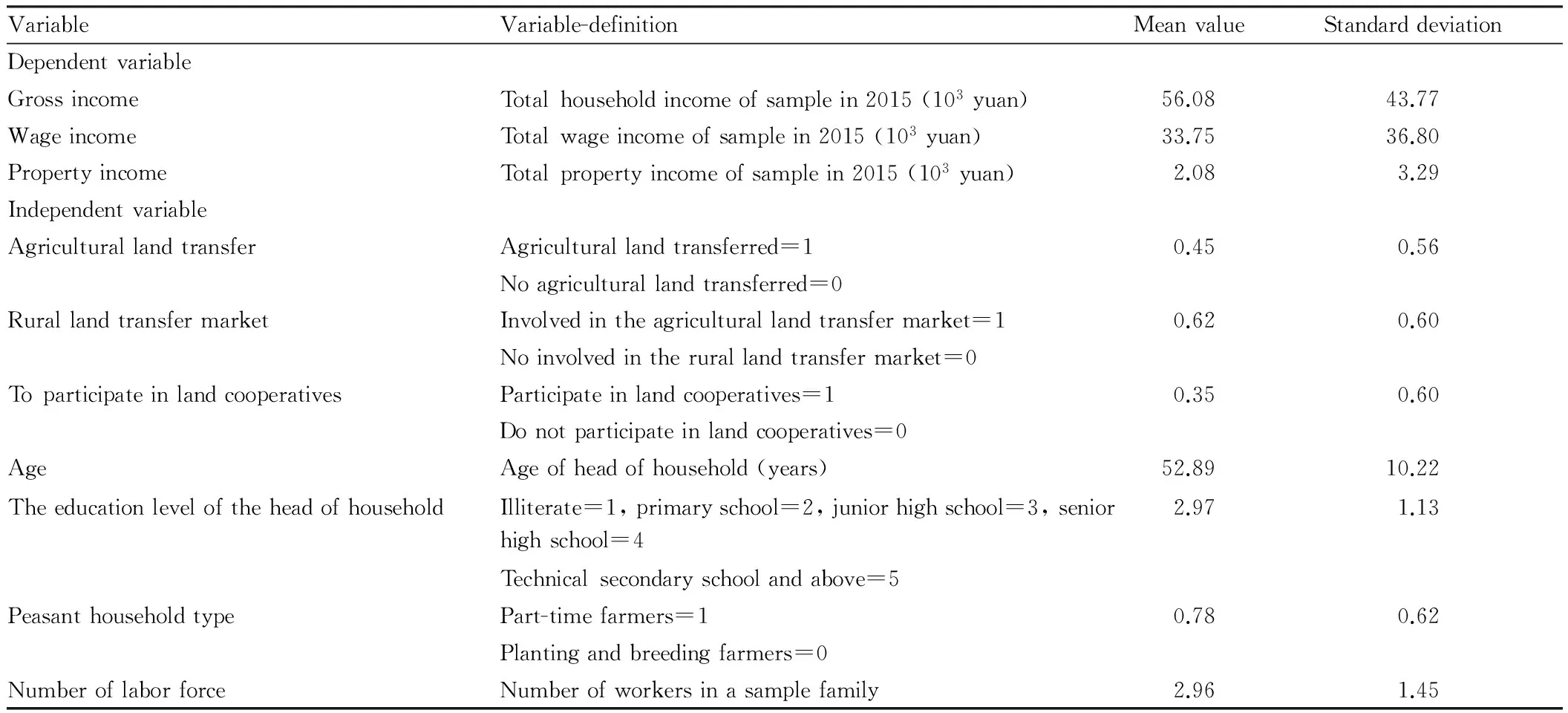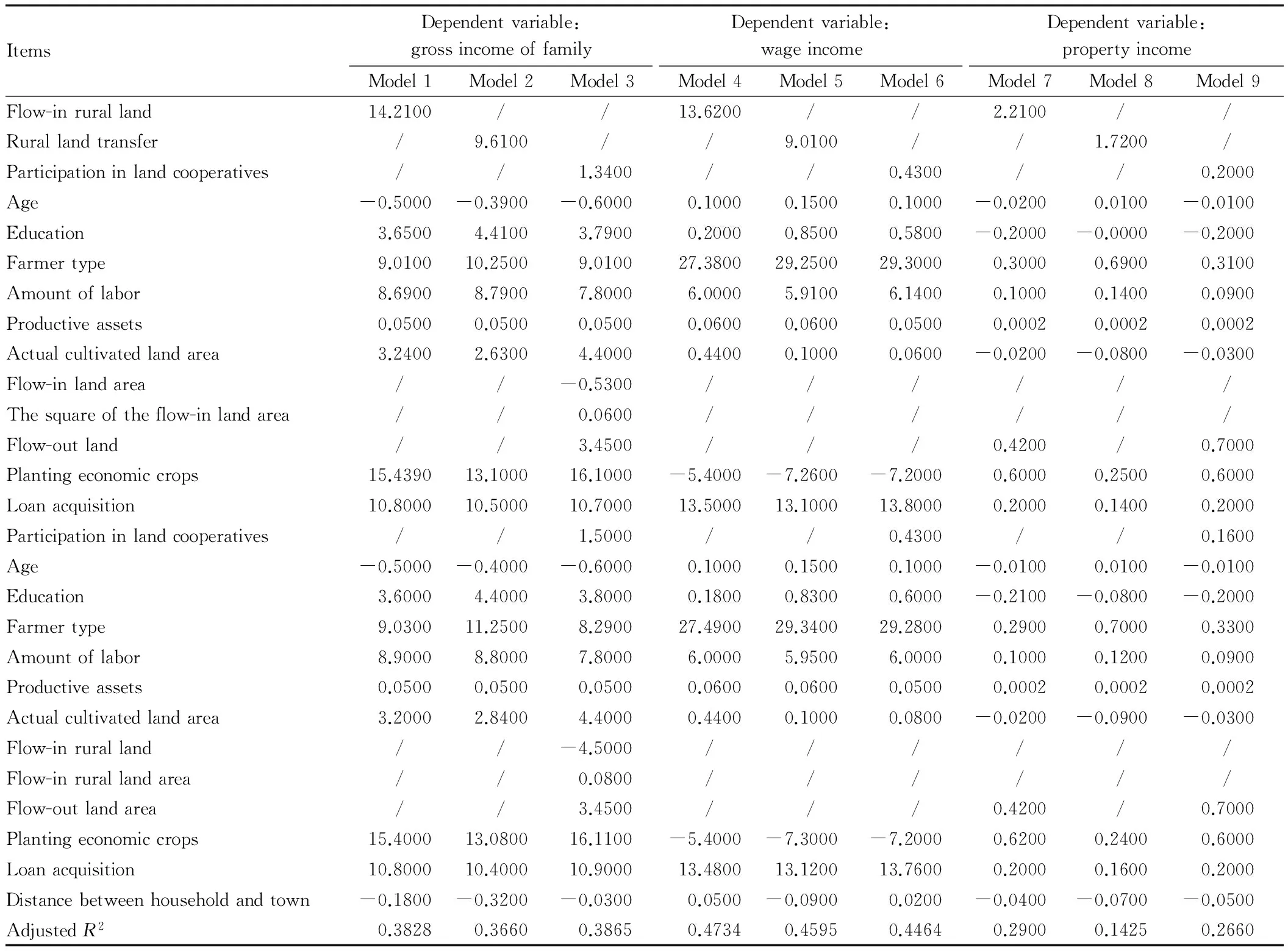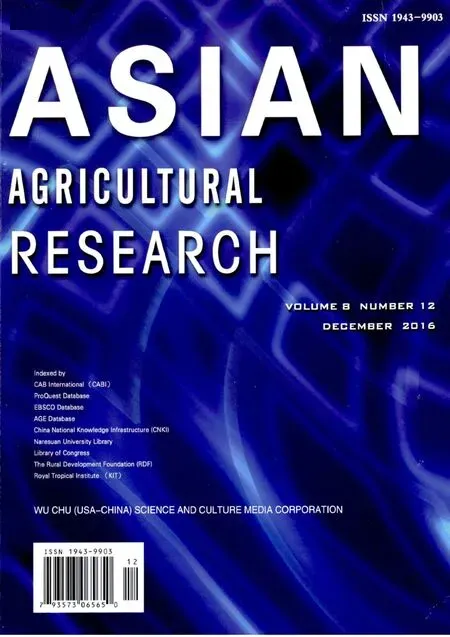Analysis of the Impact of Rural Land Transfer on Farmers’ Income: A Case Study of Farmers in Zaozhuang City
,
1.College of Economics and Management, Zaozhuang University, Zaozhuang 277100, China; 2. College of Economics and Management, China Agricultural University, Beijing 100083, China
1 Introduction
For the vast majority of the world’s rural poor population, land is the largest and only asset. Some economists call it "sleeping capital", thinking that the activation of "sleeping capital" is essential for economic development and improvement of the income of the poor. However, in many developing countries, due to the uncertainty and legal restrictions, farmers’ land rights can not be freely transferred in the market, which leads to the low market value of the land[1]. In recent years, with the transfer of rural surplus labor to non-agricultural industries, the degree of dependence of farmers on land is reduced, so on the basis of ensuring that the land contract right is constant, many local governments actively cultivate the land transfer market, and encourage farmers to use the ways of transfer, share, cooperation and leasing to circulate their land management rights, so as to improve the configuration mode of land, capital and labor in rural areas, which has an important impact on agricultural output and farmers’ income[2].
2 Analysis of the mechanism about influence of rural land transfer system on farmers’ income
This paper selects Zaozhuang as a sample region which is a prefecture-level city in the southern part of Shandong Province. Latest data show that the area of Zaozhuang City is 4563 km2, it has five districts, and the agricultural population is up to 2.5499 million. More than 40% of the rural youth labor forces become migrant workers throughout the year, providing a prerequisite for the reform of the rural land circulation, scale management and a series of agricultural land property right system reforms. According to the data, there are 800 thousand acres of land for circulation, and the land transfer ratio reaches 37.2%. At present, there are various ways of farmland circulation in Zaozhuang, some of which are dominated by individual farmers, some led by the government while others are market-driven. The different pattern of rural land transfer shows different degree of marketization. Firstly, according to the income level of farmers and agricultural management characteristics, the paper selects 4 districts from 6 areas in Zaozhuang City, and then according to the reform of rural land property rights system, selects 2 towns in each district, 2 villages in every town, 8 to 15 agricultural business entities in every village randomly. The final sample includes 6 rural land cooperatives, 4 rural professional cooperatives, 6 specialized households and 162 traditional peasant households. Finally, after eliminating some questionnaires with missing data, the number of effective samples is 150. The questionnaire survey mainly covers the individual characteristics of farmers, family characteristics, assets income, manufacturing & managing activities, as well as rural financial market participation, etc. By comparison, this paper draws the following conclusions: first of all, the gradual development of the rural land transfer market has a positive impact on the income level of farmers, the income of the farmers who participate in the circulation of agricultural land is higher than that of the farmers who do not participate in the rural land circulation, and the income gap mainly comes from the salary income (including agricultural and non-agricultural wage income) and property income[3]; secondly, agricultural land transfer has a significant impact on household income, wage income, property income; in addition, agricultural land transfer also has some positive impact on income structure, wage income and property income of farmers involved in the transfer of rural land (Table 1). In order to study the influence of the rural land circulation on the total income and income structure of farmers, this paper selects the total household wage income, property income as the dependent variables, whether to transfer agricultural land, whether to participate in the agricultural land transfer market and whether to participate in land cooperatives as the independent variables. Specific variables and statistics are shown in Table 2. In order to investigate the impact of the agricultural land transfer, participation in the rural land transfer market and land cooperatives on the total income, wage income and property income of the farmers, the paper builds 9 multiple regression analysis models, and uses STATA 11 software to do econometric analysis. Specific results are shown in Table 3. According to the analysis results, the paper points out that the impact of rural land transfer on the total income of farmers is significantly positive. This shows that after the transfer of agricultural land, farmers can engage in more efficient economic activities, resulting in higher income. The impact of household labor quantity, productive assets, and the actual cultivated land area, whether to grow economic crops or not on the total income of the farmers is also significantly positive[4]. More family labor, more productive assets, and more land to cultivate, will lead to higher total household income of farmers. In addition, the effect of credit acquisition on the total income of farmers is significantly positive. It means that the acquisition of credit funds has a positive impact on farmers’ production and business activities. We can see from model 4 to 6 that the influence of rural land transfer and participation in the rural land transfer market on the wage income of farmers is significantly positive. The participation in the land cooperatives has no significant impact on the wage income of farmers. This shows that after the transfer of land, farmers can engage in non-agricultural employment, gaining higher wage income. The household type, workforce?quantity and productive assets have significant impact on the wage income of farmers. Generally speaking, part-time farmers have more opportunities to engage in non-agricultural activities, so as to have higher non-agricultural wage income. This means that the rural land transfer system reform has promoted the further division of labor in rural areas. The results from model 7 to 9 show that the influence of the agricultural land transfer and participation in the rural land transfer market on the property income of farmers is significantly positive. The property income of farmers in the sample area is mainly the land rent. This means that the farmers involved in the transfer of rural land can get higher property income. It’s worth noting that the influence of the distance between farmers and town on the property income of farmers is significantly negative, the farther away from the town, the lower the rent and the lower the property income of farmers.
Table1TherelationshipbetweenrurallandcirculationandhouseholdincomeinZaozhuangin2015

HouseholdincometypeIncomeoffarmerswhoparticipateinfarmlandcirculation∥yuanProportion∥%Incomeoffarmerswhodonotparticipateinfarmlandcirculation∥yuanProportion∥%Agriculturalmanagementincome800.605.411200.0013.41Graincropincome320.002.16467.895.23Economiccropincome480.603.25453.665.07Livestockbreedingincome0.000.00278.453.11Wageincome12006.7881.096546.3473.17Propertyincome800.005.400.000.00TransferIncome1200.008.101200.0013.41Theaverageruralhouseholdincome14807.38100.008946.34100.00
Table2Specificvariablesandstatistics

VariableVariable-definitionMeanvalueStandarddeviationDependentvariableGrossincomeTotalhouseholdincomeofsamplein2015(103yuan)56.0843.77WageincomeTotalwageincomeofsamplein2015(103yuan)33.7536.80PropertyincomeTotalpropertyincomeofsamplein2015(103yuan)2.083.29IndependentvariableAgriculturallandtransferAgriculturallandtransferred=10.450.56Noagriculturallandtransferred=0RurallandtransfermarketInvolvedintheagriculturallandtransfermarket=10.620.60Noinvolvedintherurallandtransfermarket=0ToparticipateinlandcooperativesParticipateinlandcooperatives=10.350.60Donotparticipateinlandcooperatives=0AgeAgeofheadofhousehold(years)52.8910.22TheeducationleveloftheheadofhouseholdIlliterate=1,primaryschool=2,juniorhighschool=3,seniorhighschool=42.971.13Technicalsecondaryschoolandabove=5PeasanthouseholdtypePart-timefarmers=10.780.62Plantingandbreedingfarmers=0NumberoflaborforceNumberofworkersinasamplefamily2.961.45
(to be continued)
(continued)

VariableVariable-definitionMeanvalueStandarddeviationProductiveassetsThepresentvalueofproductiveassetsownedbythesamplehouseholdsin2016(103yuan)33.20253.85ActualcultivatedlandareaActualcultivatedlandarea(ha)0.370.31InflowinglandareaInflowinglandarea(ha)0.080.23OutflowinglandareaOutflowinglandarea(ha)0.070.12PlantingeconomiccropsPlanteconomiccrops=10.610.59Donotplanteconomiccrops=0LoanacquisitionLoanacquisition=10.450.61Noloanacquisition=0DistancefromtownDistanceBetweensamplefamilyandtown(km)11.305.24
Table3Dataspecification

ItemsDependentvariable:grossincomeoffamilyModel1Model2Model3Dependentvariable:wageincomeModel4Model5Model6Dependentvariable:propertyincomeModel7Model8Model9Flow-inruralland14.2100//13.6200//2.2100//Rurallandtransfer/9.6100//9.0100//1.7200/Participationinlandcooperatives//1.3400//0.4300//0.2000Age-0.5000-0.3900-0.60000.10000.15000.1000-0.02000.0100-0.0100Education3.65004.41003.79000.20000.85000.5800-0.2000-0.0000-0.2000Farmertype9.010010.25009.010027.380029.250029.30000.30000.69000.3100Amountoflabor8.69008.79007.80006.00005.91006.14000.10000.14000.0900Productiveassets0.05000.05000.05000.06000.06000.05000.00020.00020.0002Actualcultivatedlandarea3.24002.63004.40000.44000.10000.0600-0.0200-0.0800-0.0300Flow-inlandarea//-0.5300//////Thesquareoftheflow-inlandarea//0.0600//////Flow-outland//3.4500///0.4200/0.7000Plantingeconomiccrops15.439013.100016.1000-5.4000-7.2600-7.20000.60000.25000.6000Loanacquisition10.800010.500010.700013.500013.100013.80000.20000.14000.2000Participationinlandcooperatives//1.5000//0.4300//0.1600Age-0.5000-0.4000-0.60000.10000.15000.1000-0.01000.0100-0.0100Education3.60004.40003.80000.18000.83000.6000-0.2100-0.0800-0.2000Farmertype9.030011.25008.290027.490029.340029.28000.29000.70000.3300Amountoflabor8.90008.80007.80006.00005.95006.00000.10000.12000.0900Productiveassets0.05000.05000.05000.06000.06000.05000.00020.00020.0002Actualcultivatedlandarea3.20002.84004.40000.44000.10000.0800-0.0200-0.0900-0.0300Flow-inruralland//-4.5000//////Flow-inrurallandarea//0.0800//////Flow-outlandarea//3.4500///0.4200/0.7000Plantingeconomiccrops15.400013.080016.1100-5.4000-7.3000-7.20000.62000.24000.6000Loanacquisition10.800010.400010.900013.480013.120013.76000.20000.16000.2000Distancebetweenhouseholdandtown-0.1800-0.3200-0.03000.0500-0.09000.0200-0.0400-0.0700-0.0500AdjustedR20.38280.36600.38650.47340.45950.44640.29000.14250.2660
3 Conclusions
Overall, it can be initially considered that the impact of the reform of rural land transfer system on farmers’ income is mainly based on the reallocation of the rural land and rural labor, to improve the allocation efficiency and production efficiency, thus improving the income level[5]. At the same time, the reform of the rural land transfer system also has certain influence on income structure, wage income and property income of farmers. The income of farmers who participate in the reform increases significantly. However, from the angle of field survey and empirical results, the organization effect and mortgage effect of the rural land transfer system reform are not significant. It may be due to government or individual farmers. Therefore, to further deepen the reform of rural land system in the future, we should fully respect the farmers’ willingness, give full play to the leading role of the rural cooperatives, and improve therelevant legal system, promote the construction of rural financial market and other relevant elements of the market, so as to effectively activate the property rights of farmers.
[1] SHI QH. Evolvement and developing source of farm household’s behavior on farmland transferring[J]. Journal of South China Agriculture University (Social Science Edition),2007(3). (in Chinese).
[2] LIU JJ. The influence of rural land property right system reform on farmers’ income[J]. Issues in Agricultural Economy, 2015(6). (in Chinese).
[3] Rural land question in China: Analysis and recommendations based on a seventeen-province survey[R]. RDI Report,2006.
[4] WANG ZX. A survey on willingness of farm land transfer in Cangshan County: Features and influencing factors[J]. Journal of Huazhong Agricultural University(Social Sciences Edition),2010(6). (in Chinese).
[5] WANG WC. Analysis on the present situation and development trend of farmland transfer in Shandong Province[J]. Land and Resources Information 2015(11). (in Chinese).
 Asian Agricultural Research2016年12期
Asian Agricultural Research2016年12期
- Asian Agricultural Research的其它文章
- How to Improve Tea Farmers’ Livelihoods in the Sightseeing Place along Lijiang River Valley?
- Brand Construction of Agricultural Enterprises: A Case Study of Hubei Hanway Ecological Agriculture Group
- Impact of Online Comments on Purchase Intention of College Student Consumers under Online Shopping
- Empirical Research on Farmer’s Breaching Behavior in Order Contract
- Suitability Evaluation of Garden Landscape in Chizhou Residential Area
- Effect of Vector Density and Competence on Macromolecular Vector Transformation Efficiency
